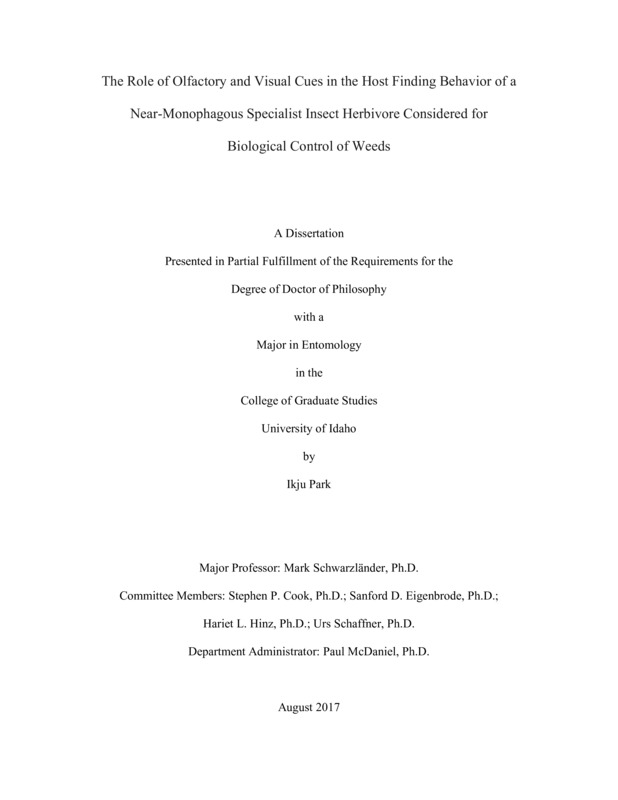The role of olfactory and visual cues in the host finding behavior of a near-monophagous specialist insect herbivore considered for biological control of weeds
Park, Ikju. (2017). The role of olfactory and visual cues in the host finding behavior of a near-monophagous specialist insect herbivore considered for biological control of weeds. Theses and Dissertations Collection, University of Idaho Library Digital Collections. https://www.lib.uidaho.edu/digital/etd/items/park_idaho_0089e_11170.html
- Title:
- The role of olfactory and visual cues in the host finding behavior of a near-monophagous specialist insect herbivore considered for biological control of weeds
- Author:
- Park, Ikju
- Date:
- 2017
- Embargo Remove Date:
- 2021-03-28
- Program:
- Plant, Soil and Entomological Sciences
- Subject Category:
- Entomology
- Abstract:
-
Current pre-release testing procedures in biological weed control primarily rely on choice and no-choice development, feeding, and oviposition tests to evaluate the environmental safety of prospective biocontrol agents. Examining behavioral responses of prospective organisms to olfactory and visual cues can improve pre-release risk assessments because these cues mediate host-plant recognition that necessarily precedes feeding and oviposition in the field. I investigated how the seed-feeding weevil Mogulones borraginis distinguishes its European field host, the rangeland weed, Cynoglossum officinale from eight North American confamilial plant species based on olfactory and visual cues in behavioral assays and electrophysiological experiments. Ten electrophysiologically-active semiochemicals were identified using gas chromatography and electroantennographic detection combined with flame ionization detection (GC-EAD/FID) using a chiral column and gas chromatography-mass spectrometry (GC-MS). Among them, (-)-α-copaene and (E)-β-farnesene were two sesquiterpenes only found in headspace volatile of C. officinale and none of the other plant species. Similarly, four electrophysiologically-active wavelengths of light were identified for M. borraginis at 350 nm (ultraviolet), 430 nm (purple), 640 nm (red) and 830 nm (infrared), respectively using electroretinography (ERG), multispectral images of inflorescences, and a photo-radiometer. I designed a double-stacked y-tube device (D-SYD) that allows conducting behavioral assays with visual and olfactory cues simultaneously, and a portable volatile collection system (PVCS) to collect headspace volatile nondestructively from plants in the field. In behavioral assays, weevils clearly distinguished C. officinale from each confamilial plant species, including four federally listed threatened and endangered plant species based on either floral scents or visual cues from flowering stems. Both cues offered simultaneously to M. borraginis resulted in relatively stronger and faster discrimination. When cues were mismatched, weevils were no longer able to discriminate between two plant species and exhibited long searching times in behavioral assays. The relative strength of olfactory and visual cues was equally important for the host selection behavior of M. borraginis. In sum, studies of behavioral responses to olfactory and visual cues and underlying mechanisms will advance our understanding of how herbivores considered as biocontrol organisms achieve discrimination among closely related plant species and may allow better delineating experimentally realized and fundamental host ranges of weed biocontrol organisms.
- Description:
- doctoral, Ph.D., Plant, Soil and Entomological Sciences -- University of Idaho - College of Graduate Studies, 2017
- Major Professor:
- Schwarzländer, Mark
- Committee:
- Eigenbrode, Sanford D; Cook, Stephen P; Hinz, Hariet L; Schaffner, Urs
- Defense Date:
- 2017
- Identifier:
- Park_idaho_0089E_11170
- Type:
- Text
- Format Original:
- Format:
- application/pdf
- Rights:
- In Copyright - Educational Use Permitted. For more information, please contact University of Idaho Library Special Collections and Archives Department at libspec@uidaho.edu.
- Standardized Rights:
- http://rightsstatements.org/vocab/InC-EDU/1.0/

